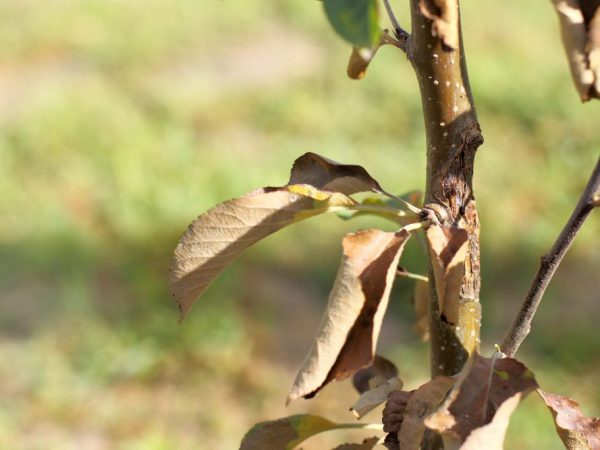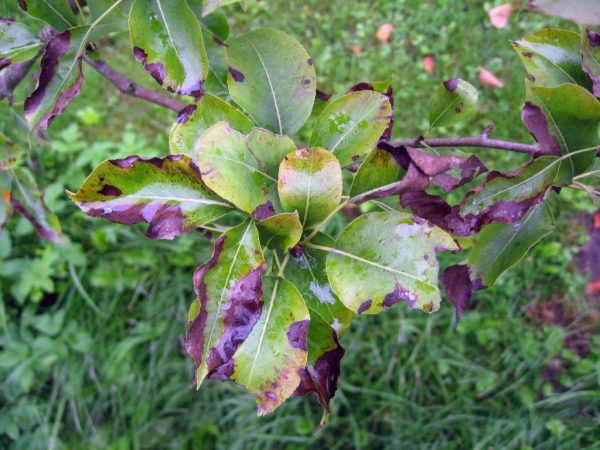Causes of leaf curling in pears
Pear leaves are a reflection of its condition. If the leaves of the pear are curled, you must immediately determine the source of the problem.

Causes of leaf curling in pears
Twisting can be fought with both folk methods and chemical means. It depends on the factor that influences this process.
Causes
- insufficient amount of moisture;
- the plant does not receive enough nutrients;
- freezing of plant roots;
- the action of bacterial infections and diseases;
- defeat by various pests;
- defeat by different viruses.
In order to find the reason for curling the leaves on the pear, you need to carefully examine the plant to determine the circle of damage. You can get rid of this unpleasant phenomenon by prophylactic spraying of the tree, but in some cases it may be necessary to cut down the pear.
Watering
An adult tree needs 2-3 buckets of water for 1 year of life.
To protect the crop during drought, it is important to mulch. You can add peat, grass or even paper. So the soil of the trunk circle will retain moisture longer.
Top dressing
Twisting can be prevented by timely feeding:
- Calcium. From its lack, the foliage begins to turn black, and the edges gradually curl upward. To prevent this, the pear needs to be fed with ash. For 1 square meter, 3-4 glasses of ash will be required. It is sprinkled with the near-stem circle of the plant, immediately after that, the pear must be watered so that all the nutrients get to the root system.
- Bor. It happens that with a lack of this element, the leaves on young seedlings begin to spin, and new branches stop growing and developing, because all metabolic processes are slowed down.
- Phosphorus. From its lack, the lower leaves become small, turn black, curl, and then crumble. To eliminate this problem, you need to take 15-20 kg of superphosphate per 100 kg of manure and fertilize the tree with this agent. If you feed with superphosphate and manure separately, then you will not have the desired result.
It is important to adhere to all agrotechnical measures. If damaged leaves are seen on the fruit crop, they must be removed immediately. It happens that the circle of defeat extends to the branches, they also need to be cut off.
Bacterial and fungal infections
If the leaf mass of the culture was fed, and the positive results were not noticed, then, most likely, the tree was struck by such a disease as the furrowing of the trunk.
It manifests itself in early spring. Cracks appear on the trunk, which open the way for various infections. In the tree, all metabolic processes between the root and the upper part of the culture are disrupted. Most often, this disease affects plants 2-3 years old. If the seedling is younger, then it dies.

A diseased tree does not respond to treatment
The furrowing provokes a painful microflora, which enters along with rainwater through mechanical damage. If the leaves are curled up, then this is the initial stage of the disease.Over time, the fruits become stained. And as a result, the tree looks burnt.
The only way out is to cut down the pear, dig up the roots and burn it all. And in the place where the infected plant grew, do not plant anything in the next 2 years.
Pests
One of the most common pests that provoke leaf curling is aphids. The affected leaves first turn black, then curl up, and then completely fall off. This small insect can be fought with folk methods and chemicals.
Traditional methods
This method is harmless and the most economical. Aphids multiply rapidly, which is why they negatively affect the development of the pear. And to stop its destructive effect, use a herbal tincture of celandine.
To prepare it, you need to take 4-5 branches of celandine. Grind them (always with gloves) and add to 1 bucket of boiled water. The infusion should be covered and left warm for 5 days. For the solution, you need 200 ml, which must be diluted in 10 liters of water.
Spraying with this agent must be carried out 3-6 times (it depends on the number of pests). The average interval is 5 days.
Chemicals
It is necessary to treat aphid culture with chemicals with extreme caution, 25-30 days before harvesting.
To combat the pest, you can use the following drugs:
- Kinmix. This remedy is used in early spring, before the development of the kidneys. To process the culture, you need to take 2.5 ml of the drug and dilute it in 1 liter of water, after which this solution is diluted in 10 liters of water and sprayed with a pear. This remedy protects the culture for 2 to 3 weeks.
- Agravertine. Apply before the beginning of the flowering period. First, you need to dilute 5 ml of the drug in 1.5 liters of water, and then pour this solution into 10 liters of water. The leaves must be processed very carefully so as not to leave pests. Otherwise, there will be no sense from spraying.
- Spark. The drug is strong. He fights not only with aphids, but also with other pests. For the solution, use 1 tablet of the drug per 10 liters of water. The product can be used after the fruit has been set.
All chemicals must be used according to the instructions and at a temperature not lower than 16 °, but not higher than 25 °.
The combined use of these products will be an excellent method of dealing with curled leaves in the early stages. Chemicals are recommended to be used only in emergency cases when there is a serious threat to the plant and traditional methods do not help solve the problem.
Prophylaxis
In order to prevent damage and twisting of pear leaves, you still need to perform some preventive actions in time:
- do sanitary pruning of the crown;
- comply with all the rules for watering and feeding the crop;
- constantly remove and destroy fallen leaves;
- process the trunk with lime.
In early spring, trees are recommended to be treated with Bordeaux liquid. To prepare it, you need to take 100 g of copper sulfate and 100 g of quicklime for 8 liters of water. When properly prepared, the mixture is sky blue with a dark blue sediment.
You also need to remember that the solution is used on the day of preparation, because after a day it loses its beneficial effect. Spraying can be carried out several times, but not during the flowering period.
Young leaves curl on the pear also due to freezing of the plant roots. To avoid this, the tree needs to be fed with a mullein in the fall, and in early spring, carry out comprehensive feeding and protection measures.
Conclusion
Rolling leaves on a pear is a common occurrence. It is important to quickly find the reason for which it was formed. The choice of a method of action in the fight against twisted foliage depends on this. There are chemical and folk remedies, agrotechnical measures.
Chemicals are used for serious diseases, folk - for a small infected circle. Agrotechnical techniques help prevent the appearance of twisted foliage.


